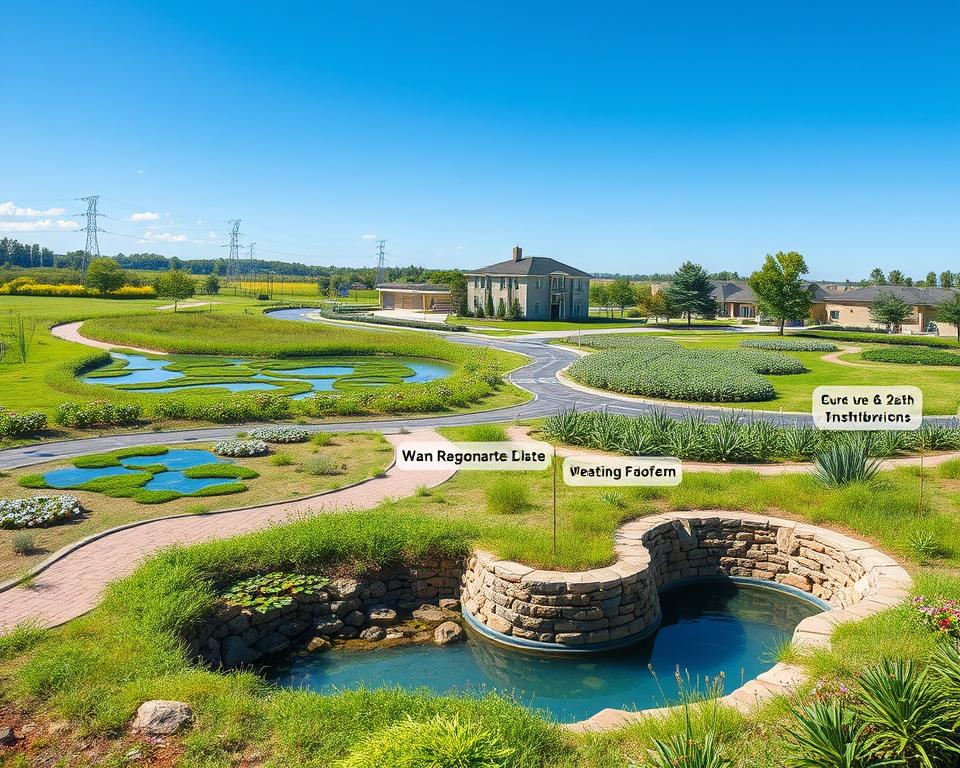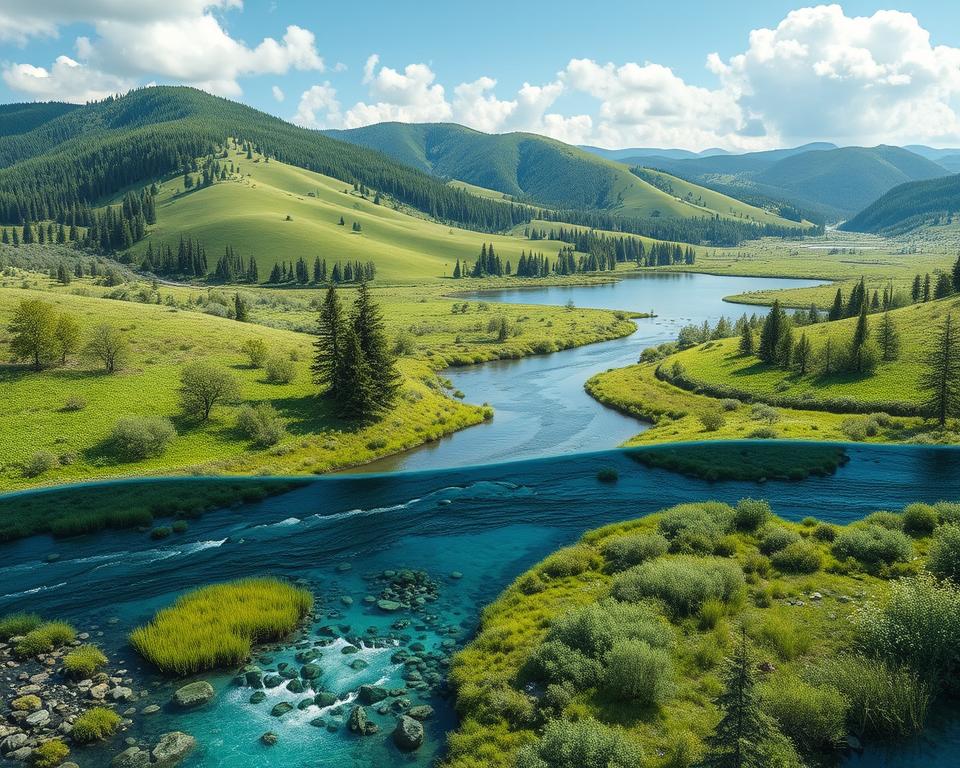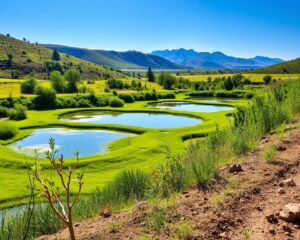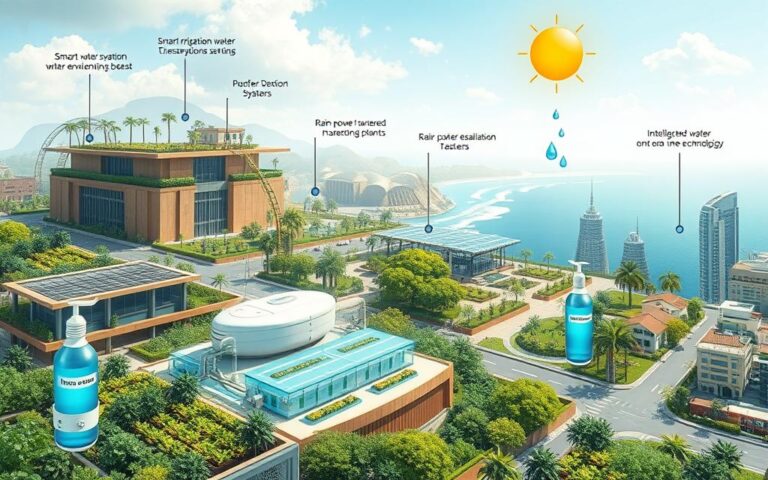In the United States, about 77 billion gallons of fresh groundwater are pumped every day. This is roughly 8% of the 1 trillion gallons nature replenishes daily. This shows how important it is to manage our freshwater resources well.
Large users like data centers and big farms want to use more water, especially in places like the Great Lakes. This makes it even more crucial to manage water sustainably. We need to make sure future generations can still have access to this vital resource.
Aquifer recharge is key to keeping our groundwater supplies full. As cities grow and climate changes, knowing how to refill aquifers is more important than ever. There are natural ways and man-made systems to do this.
By using these methods, you can help make water more resilient. This way, we can protect this essential resource for many years.
Understanding Freshwater Resources
Freshwater is key for life and comes from lakes, rivers, and underground water. It’s vital for people and ecosystems around the world. Without enough freshwater, meeting basic needs like drinking and food becomes hard. Learning about these resources helps us manage and protect them for the future.
What Are Freshwater Resources?
Freshwater is water that’s not salty, found in rivers, lakes, and underground. It’s essential for our planet’s health and supports many activities. Storing water properly helps keep it available for longer.
Importance of Freshwater for Life
Freshwater is vital for our survival. It affects many parts of our lives, like:
- Drinking water supply
- Agricultural irrigation
- Industrial processes
- Habitat for aquatic and terrestrial species
Groundwater is especially important, as it’s a reliable source even in dry times. This highlights the need for careful management of these resources.
Current Global Freshwater Distribution
Only about 3% of the world’s water is freshwater, with less than 1% easily accessible. Most freshwater is in glaciers, ice caps, or deep underground. Here are some key facts about freshwater distribution:
| Source | Percentage of Total Freshwater |
|---|---|
| Glaciers and Ice Caps | 68.7% |
| Groundwater | 30.1% |
| Surface Water | 1.2% |
| Rivers and Lakes | 0.006% |
Given the limited amount, it’s crucial to manage freshwater sustainably. This is key to solving today’s and tomorrow’s challenges.
The State of Freshwater in the United States
Freshwater is key to daily life in the U.S. and the environment. It’s important to know about water scarcity and how to replenish groundwater. This section looks at statistics, major sources, and areas facing water challenges.
Key Statistics You Should Know
Freshwater use gives us insights into how we use this resource. Here are some important statistics:
| Statistic | Value |
|---|---|
| Total freshwater withdrawn daily | 349 billion gallons |
| Groundwater as percentage of total withdrawals | 26% |
| Average annual groundwater withdrawals (2010) | 27.7 trillion gallons |
| Percentage of groundwater used for irrigation | 43% |
| Percentage of U.S. population relying on groundwater for drinking | 38% |
Major Sources of Freshwater in America
Most freshwater in the U.S. comes from groundwater. It’s vital to replenish these resources. Here are the main uses of freshwater:
- Irrigation (65%)
- Public Supply (21%)
- Domestic Self-Supply (5%)
California uses the most water, pumping over 17.4 billion gallons daily. Texas has the most irrigation wells. Areas relying on groundwater are at risk from overuse.
Regions Facing Water Scarcity
Many U.S. regions face water scarcity, often due to too much groundwater use. States like Kansas, Arkansas, and Mississippi rely heavily on groundwater. Here are some states with high groundwater use:
- Kansas: 80%
- Arkansas: 69%
- Mississippi: 68%
- Florida: 64%
- Hawaii: 63%
It’s crucial to understand these challenges to improve water management.
The Impact of Climate Change on Freshwater
Climate change is changing how we get freshwater. It’s making temperatures rise, changing when it rains, and causing more droughts. These changes make it hard to keep our water sources full. It’s key to understand these changes to manage water well.
Rising Temperatures and Their Effects
As the world gets warmer, more water evaporates. This means less water is left in underground aquifers. Places that count on this water for drinking are facing big challenges. The Southern Plains in the U.S. are already seeing their groundwater levels drop.
This shows we need to act fast to keep our water safe.
Changes in Rainfall Patterns
Climate change is changing where and when it rains. This messes up the natural way water fills up underground. More extreme weather makes managing water even harder.
Places like California’s Central Valley might see less water underground. This makes finding ways to refill aquifers even tougher.
The Threat of Drought
Droughts are getting worse and more common with climate change. This is bad news for places already short on water. The Middle East is facing big problems keeping its groundwater levels up.
We need to find new ways to manage water. This includes watching water levels closely and finding new ways to refill aquifers.
| Impact Area | Current Conditions | Future Projections |
|---|---|---|
| Groundwater Storage | Declining levels due to climate effects | Reduced availability under business-as-usual scenarios |
| Evaporation Rates | Increase due to rising temperatures | Worsening water scarcity across various regions |
| Rainfall Patterns | Unpredictable, with extreme events | Continued disruption to natural recharge processes |
| Drought Frequency | More severe droughts affecting water supply | Increased risk for populous areas |

Everyday Choices That Affect Freshwater
Your daily choices are key to saving freshwater. By using less water and making smart buys, you help the planet. Knowing how your actions affect water is crucial for a green future.
Water-Saving Techniques for Your Home
Simple steps at home can cut down your water use. Here are some tips:
- Fix leaks fast to save water.
- Choose water-saving fixtures in your home.
- Use rainwater for plants to refill groundwater.
- Shorten your showers to use less water.
- Only run full loads in dishwashers and washing machines.
Choosing Sustainable Products
Choosing eco-friendly products helps a lot. Look for items that use less water and resources. Support companies that care about the planet and use water wisely.
Reducing Water Footprint
Lowering your water footprint is more than just personal actions. It’s about how your lifestyle affects the environment. Here are some ideas:
- Think about what you eat, as some foods use a lot of water.
- Teach others why saving water is important.
- Join local efforts for a greener future.
- Use plants that need less water in your garden.
Freshwater Conservation Practices
It’s vital to protect freshwater for future generations. Simple steps can help keep our aquifers healthy and support groundwater. These efforts are key to ensuring clean water for everyone.
Simple Ways to Conserve Water
Every small action helps in saving water. Here are some easy ways to conserve:
- Rooftop rainwater harvesting: Use rainwater for toilets and plants.
- Drip irrigation: Water plants directly at their roots.
- Contour farming: Stop soil erosion and manage water runoff.
- Micro-irrigation: Water plants precisely to save water.
- Fixing leaks: Fix leaks fast to save water.
The Role of Technology in Preservation
Technology helps us manage water better. Smart meters show how much water we use. This helps us make better choices.
Advanced irrigation systems use sensors for better watering. Rain-MAR helps keep stormwater for farming. These methods help recharge aquifers and reduce runoff.
Community Initiatives You Can Join
Joining local programs can make a big difference. Many communities work on water conservation. Here’s how you can help:
- Join clean-up events to protect water sources.
- Learn about water conservation through educational programs.
- Support Rain-MAR projects for better aquifer recharge.
By joining these efforts, you help protect this essential resource. You also support sustainable water management.
The Importance of Watersheds
Watersheds are key ecosystems that collect and store freshwater. They play a big role in managing water, especially in replenishing aquifers and recharging groundwater.
What Is a Watershed?
A watershed is all the land that drains into a body of water like rivers, lakes, or reservoirs. It’s vital for storing water, keeping it clean, and supporting local life. This system also filters out pollutants and helps biodiversity thrive.
How You Can Protect Local Watersheds
There are many ways to help your local watershed. Here are a few:
- Reduce pollution by disposing of chemicals and waste correctly.
- Join community clean-up efforts to clear waterways of debris.
- Support policies that protect the environment.
- Use sustainable practices at home, like harvesting rainwater and planting native plants.
The Impact of Urban Development
Urban growth can harm natural watersheds. Roads and buildings block water flow, hurting aquifer replenishment. But, using green infrastructure like permeable pavements and green roofs can help. This makes urban watersheds healthier.

Government Policies on Water Preservation
Government policies are key to managing water sustainably. New laws show a growing focus on keeping our water fresh. Knowing these laws helps you join the conversation on water management.
Current Legislation You Should Know About
Several laws shape water use in the U.S.:
- House Bill 1989, from the 74th Texas Legislature, helps use surface water for Aquifer Storage and Recovery (ASR).
- House Bill 655, passed in 2015, made it easier to get permits for ASR projects.
- In 2019, House Bill 721 asked the Texas Water Development Board to study aquifers for ASR and recharge. They had to report by December 2020.
- House Bill 720 lets us use water like stormwater for recharge projects.
Federal vs. State Water Policies
Federal and state water policies have big differences. Federal laws, like the Safe Drinking Water Act, set basic quality standards. State laws, on the other hand, focus on local needs. For example, Texas has rules for ASR projects to help manage water better.
How You Can Advocate for Change
Want to help save water? Here’s how:
- Talk to your local reps about the need for better water management.
- Go to community forums to support local recharge projects and good laws.
- Join groups that fight for water protection and better policies.
- Keep up with new water laws and share what you learn with others.
Global Efforts in Freshwater Preservation
Many global efforts aim to solve freshwater problems, especially in areas with little water. These projects focus on managing water well, filling up aquifers, and finding new ways to recharge groundwater. They work to keep water safe for future generations.
Successful International Initiatives
The World Freshwater Initiative gave over $195,000 to projects in four countries. National Geographic Explorers also got up to $50,000 each for their water-saving work. These efforts are crucial, especially in places like the Colorado River Basin, which has been dry for 24 years.
Nonprofits and Organizations Making a Difference
Groups like the International Water Management Institute and Water.org are key in saving freshwater. The Guarani Aquifer System, shared by Argentina, Brazil, Paraguay, and Uruguay, shows how working together can help. Started in 2022, it aims to keep the aquifer, which is huge and supports millions, full.
How You Can Support Global Efforts
You can really help these efforts. You can donate, volunteer, or push for better water policies. Learning from successful projects can help you support local efforts to refill aquifers and use groundwater wisely.
| Initiative | Funding | Focus Area | Impact |
|---|---|---|---|
| World Freshwater Initiative | $195,000 | Freshwater conservation | Supports projects across four countries |
| National Geographic Explorers | $50,000 each | Water conservation projects | Promotes innovative water solutions |
| Guarani Aquifer Strategic Action Program | Not specified | Transboundary aquifer management | Ensures sustainable water distribution |
| Aika Kirei Documentary | Not specified | Shrinking lakes in Tanzania | Raises awareness on environmental threats |
The Future of Freshwater Preservation
Keeping our freshwater safe relies on new ideas. Technologies that help refill groundwater are key. For example, managed aquifer recharge (MAR) uses basins and ponds to add water back into the ground.
This method keeps water clean and helps fight climate change. It keeps groundwater levels steady and fills up surface water too.
Innovative Solutions on the Horizon
Teaching kids about saving water is crucial. By learning about water conservation, they can help protect it. They can also take care of their local water sources.
Green spaces like rain gardens and special pavements also help. They keep water clean and help refill the ground. This lets communities take care of their water in a green way.
Your Role in Ensuring Sustainable Water Use
You can help save water too. Start by using less water and supporting local efforts. You can also push for better water policies.
Every small step helps. From using less water at home to joining community projects. Together, we can keep our water safe for the future.




